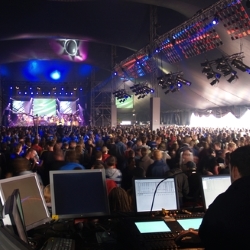Editor’s Note: This article originally appeared on the original Live Sound International website in January of 1993, and provides a lot of information that’s still relevant today. See Part 2 here.
During the intermission she leaned over the mixer complaining that the sound in Row 3 was making her ears vibrate.
My patient assurances that we would do what we could to help were interrupted by the guy from the back row who leant over the effects rack and yelled “hey buddy, are you mixing? ‘cos we can’t hear anything at the back!”
Ms. 3rd Row immediately responded that Mr. Back Row should have his head examined and he responded by suggesting, rather unkindly, that she had formed her alimentary canal into a continuous loop! Leaving them to their bickering, I headed for my intermission cup of coffee, knowing all too well that both of my critics had a point.
The Big Idea
For all the Cathode Ray Tube (CRT) displays of the signal processing and system control technology available to us today, the final interface between that technology and the listening audience remains, all too often, as it has for the past 25 years. Namely, a huge stereo whose speakers are positioned either side of the stage.
Without wishing to put too fine a point on it, that approach to sound reinforcement does not work. Inevitably the result is too high an SPL at the front of the venue while the further reaches of the listening area are subjected to an acoustic quagmire wherein the sound could best be described as overly reverberant; though the term wretched would be more apt.
Enough Of This Vitriol
If this is the problem then what is its explanation and more importantly, what is the solution? The explanation is twofold. It lies in the practical problems of day to day touring, and in the popular conception of what the sound of a particular artist or act should be.
If I may take the second point first. Most of the material with which we deal, as professional sound reinforcement engineers in the concert (live) environment, was written, rehearsed, and recorded in a very different set of circumstances. One in which reverberation was a controlled, artificial enhancement of the direct sound as heard through twin monitor speakers in the sympathetic control or rehearsal room acoustics.
It is our attempt to reproduce the same direct field of sound realized in the control room, but now in the very unsympathetic acoustic of the typical arena, that we run into trouble. It seems that the most common instinctive reaction to mixing music in an uncontrolled reverberant field, is to increase direct field levels. Unfortunately, as the direct field goes, so goes the reverberant field.
How then, can we control the reverberant field, if indeed it can be controlled? Let us first look at some of the practical causes of the problem.
Acoustic Realities
Of every factor that conspires to constrain our attempts to provide quality sound-reinforcement, perhaps the most pernicious is the building itself. But let’s forget, momentarily, the acoustic problems of the structure and examine the physical restrictions imposed upon us.
The most obvious solution to the problem of excessive SPL at the front of the listening area is to hang the loudspeaker array above the arena floor, concentrate highly efficient narrow dispersion units toward the top of the array to cover the rear of the arena and gradually reduce efficiency and increase dispersion toward the bottom of the array to provide frontal coverage.
Of course, we’ve all been using ‘flown’ systems with this premise for years and they can work very well. However they don’t address the question of uncontrolled acoustics. And although most arenas have sufficient load-bearing capacity to accommodate these flown systems, many don’t.
On the indoor/outdoor amphitheater circuit, flown systems are usually possible but height limitations coupled with the rake of the seating dictate that the top components of the loudspeaker array are often level with a point considerably below rear seating areas.
Often, in theaters and ballroom you can’t fly at all. If you cannot fly the system (and therefore have to stack it on the stage or the PA wings) or cannot fly it high enough, then so much for Ms. 3rd Row and her vibrating ears. This situation, patently, is not good enough.















